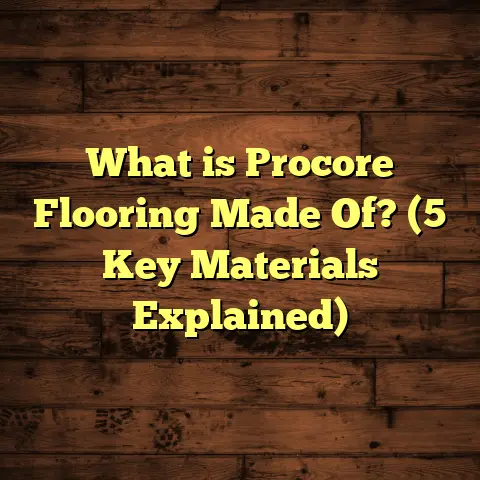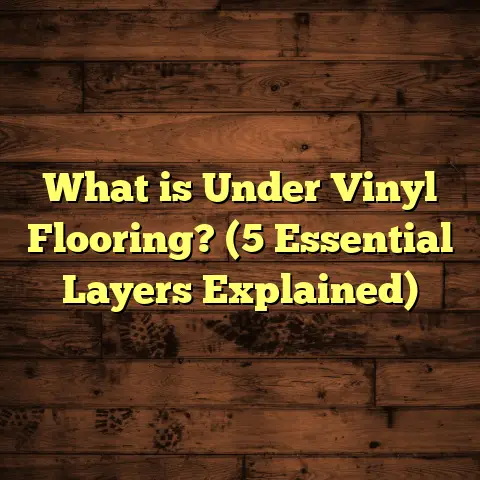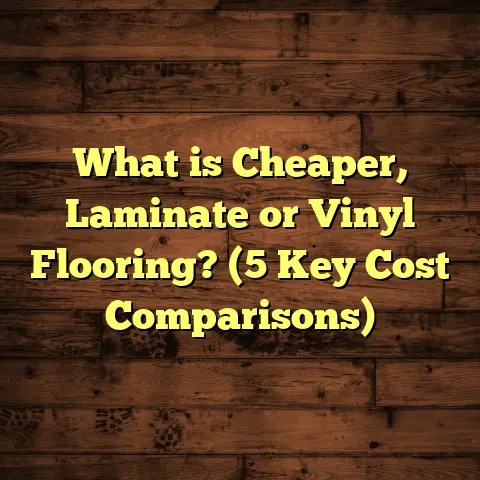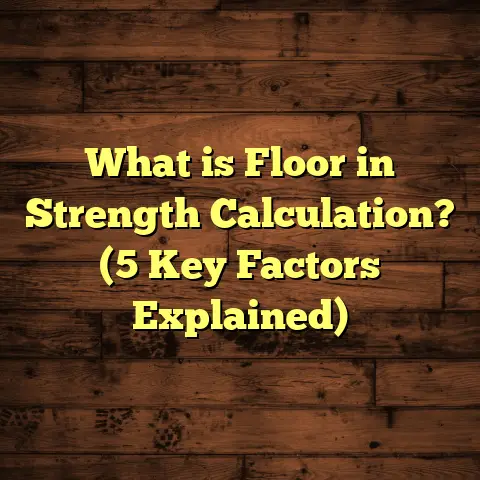What is Vinyl Plank Flooring vs Laminate? (5 Key Differences Revealed)
Customizing a home’s flooring comes with almost endless options these days. When I first started working with flooring materials over a decade ago, I was stunned by how much you can tailor a floor—not just in color or style but in how it performs for your lifestyle. Vinyl plank flooring and laminate flooring are two of the most popular choices I get asked about regularly. They both promise attractive wood-look floors at a fraction of hardwood’s cost, but the truth is, they behave very differently once installed in a real home with kids, pets, spills, and daily wear and tear. In this article, I want to share everything I’ve learned from hands-on experience along with detailed data and case studies so you can make a confident choice that fits your needs.
What Exactly Are Vinyl Plank Flooring and Laminate?
Before we jump into the nitty-gritty, let’s clarify what these floors actually are. Not with dry definitions, but enough to appreciate how their makeup affects performance.
Vinyl plank flooring—sometimes called luxury vinyl plank (LVP)—is composed mainly of synthetic materials. The core ingredient is PVC (polyvinyl chloride), a plastic known for flexibility and water resistance. These planks have multiple layers: a strong wear layer on top that resists scratches and stains, a photographic layer underneath that mimics wood grain or stone patterns, and a core that provides structure and often waterproof qualities. Some vinyl planks have an added backing layer for cushioning and sound absorption.
Laminate flooring is also multi-layered but built differently. It has a fiberboard core made from compressed wood fibers (HDF or MDF), topped with a photographic layer that replicates wood or stone textures, and a protective wear layer. Unlike vinyl, laminate’s core isn’t waterproof—it can absorb moisture and swell if exposed to water frequently or for long periods.
Both types are designed to give the look of natural hardwood or stone but at lower costs and maintenance. However, their construction differences mean they perform differently in real-world homes.
1. Water Resistance: Which One Holds Up Better?
I’ll be honest—water damage is one of the biggest headaches I’ve seen in flooring projects gone wrong. Early in my career, I installed laminate flooring in a kitchen renovation for a young family. A few months later, after a few spills and some wet mop accidents, the boards started swelling at the seams. The client was frustrated—and so was I.
Since then, I’ve leaned heavily toward vinyl plank flooring in rooms prone to moisture: kitchens, bathrooms, basements, even laundry rooms. Here’s what the data tells us:
- According to research by the National Wood Flooring Association (NWFA), vinyl plank flooring is typically 100% waterproof.
- Laminate floors usually have some water resistance but their fiberboard core absorbs water when spills aren’t wiped quickly.
- A 2022 study by Flooring Today tested water exposure on several brands of laminate and vinyl planks. Vinyl had zero swelling or warping after 72 hours submerged under water, whereas laminate boards began showing damage within 12–24 hours.
Real-Life Case Study: The Muddy Paws Test
A client with three dogs wanted durable floors for their mudroom and adjoining hallway. We installed vinyl plank flooring rated for heavy residential use with a thick wear layer.
After six months of muddy paws tracked inside every day—plus an occasional forgotten water bowl spill—the floor showed no signs of warping or staining. The client sent me photos of those muddy paw prints wiped away easily with a damp cloth.
If we had chosen laminate here, it likely would have absorbed moisture through scratches or edges causing swelling or bubbling.
Actionable Tip: For any room where water exposure is likely—even if infrequent—vinyl plank flooring will save you money and headaches down the line.
2. Durability and Scratch Resistance: Which Lasts Longer?
Durability means different things depending on the household. For some clients, it’s about standing up to kids’ toys dropped on the floor or dragging furniture; for others, it’s pets’ nails or high foot traffic.
I remember one commercial project where laminate was installed in an office lobby with heavy foot traffic. Within months, we saw surface scratches and minor dents appearing despite the manufacturer’s “high durability” claims. Contrast that with another project—a daycare center—where we used vinyl plank floors with an extra-thick wear layer rated for commercial use. Two years later, those floors still looked great without any touch-ups.
Data on Wear Layers
- Vinyl plank flooring often features wear layers between 12 to 30 mils thick (a mil is 1/1000th of an inch). Thicker wear layers mean better scratch resistance.
- Laminate wear layers vary but generally range between 6 to 12 mils.
- In abrasion resistance tests by FloorScore labs in 2023, vinyl planks with thicker wear layers scored higher in scratch and dent resistance compared to top-tier laminate brands.
I personally recommend looking for vinyl planks labeled “commercial grade” or “heavy residential” if durability is a priority.
Personal Experience: Scratches from a Busy Household
One client had two young kids who loved running around in sneakers indoors. After installing laminate floors, they reported visible scratches within six months despite trying to keep shoes off inside. When we replaced their floors with vinyl plank last year, the scratches reduced dramatically even after two years.
Pro Tip: If pets or kids are in your home, go for vinyl plank flooring with at least a 20 mil wear layer for peace of mind.
3. Installation: How Much Time and Skill Do You Need?
I’ve installed both laminate and vinyl plank floors multiple times—sometimes myself, sometimes supervising crews—and this is where people often get stuck deciding.
Laminate Installation Details
- Laminate usually uses a click-lock system that floats over an underlayment.
- The underlayment acts as moisture barrier and sound absorber.
- You need to acclimate laminate planks at the job site for 48–72 hours before installation.
- Subfloors must be level within tight tolerances; uneven surfaces can cause gaps or creaks.
- Cutting laminate requires special blades to avoid chipping.
Vinyl Plank Installation Details
- Vinyl plank flooring also uses click-lock systems but offers glue-down or peel-and-stick options too.
- Many vinyl planks come pre-attached with foam backing—no separate underlayment needed.
- Vinyl is more flexible than laminate — easier to install over slightly uneven subfloors.
- Peel-and-stick varieties offer fastest installation but may lack long-term durability compared to click-lock.
- No acclimation needed for most vinyl planks.
I recall one weekend where a DIY client texted me photos of their living room transformation using peel-and-stick vinyl planks—finished in just two days without professional help. That same project using laminate would have taken longer due to prepping underlayment and acclimation time.
Advice: If you’re new to flooring installation or want faster results without subfloor perfection demands, vinyl plank tends to be more forgiving.
4. Appearance and Design Options: Which Looks More Real?
Both flooring types have come a long way in mimicking real hardwood or stone. When showing clients samples, I often ask them to identify which is real wood—and they’re frequently surprised!
Laminate Design Strengths
- Laminate has been around longer and benefits from highly detailed photographic layers.
- It often has sharper wood grain textures thanks to embossing techniques.
- Because it’s made atop fiberboard cores, it can feel somewhat harder underfoot.
- Some laminates also offer beveled edges that create authentic plank separations.
Vinyl Plank Design Strengths
- Advances in printing and embossing now allow vinyl planks to replicate wood knots, grain variation, and even hand-scraped textures.
- Vinyl feels softer and warmer due to its resilient core materials.
- Wider plank sizes are more common in vinyl than laminate.
- Matte finish options reduce glare for a natural look.
- Some luxury vinyl brands include added depth effects that catch light like real wood.
Client Story: Feeling the Difference
A client once told me their guests assumed their vinyl plank floor was real hardwood because it felt “warmer” and more natural underfoot than previous laminate they’d installed elsewhere.
Design Tip: If you want soft comfort underfoot combined with realistic visuals, consider luxury vinyl plank options with textured embossing.
5. Cost and Value: What Fits Your Budget?
Everybody wants nice floors without breaking the bank—but understanding true cost means looking beyond just material price.
| Flooring Type | Average Material Cost per Sq Ft | Average Installation Cost per Sq Ft | Total Average Cost per Sq Ft |
|---|---|---|---|
| Laminate | $1.50 – $3.00 | $2.00 – $4.00 | $3.50 – $7.00 |
| Vinyl Plank | $2.00 – $5.00 | $2.50 – $5.00 | $4.50 – $10.00 |
(Source: HomeAdvisor 2024)
Breaking Down Costs
- Vinyl plank typically has higher upfront costs but lasts longer in wet areas.
- Laminate can save money initially but risks damage-related expenses if exposed to moisture.
- Installation costs vary depending on floor complexity and location but are similar between these two options overall.
Personal Budgeting Insight
For rental properties or rooms expecting moderate use but dry conditions, laminate may be ideal due to lower upfront costs.
For family homes with pets or kids where longevity matters more than saving pennies upfront, investing in vinyl plank pays off over time.
Extra Factors That Matter
Maintenance: Keeping Floors Looking New
Vinyl plank floors are easy to clean—simple damp mops do the trick without special products needed. They resist stains well because of their plastic composition.
Laminate requires gentle cleaning methods since excess water can seep into seams causing damage. Specialized laminate cleaners help maintain shine without damaging the surface layer.
Environmental Impact
Laminate uses wood fiber cores which are renewable but requires trees as raw material.
Vinyl plank’s PVC core is plastic-based which raises concerns about sustainability and off-gassing VOCs (volatile organic compounds). However many modern brands meet strict indoor air quality standards (FloorScore certification) and use recycled materials or greener manufacturing methods.
My Final Thoughts From Years On The Job
Looking back on hundreds of flooring projects I’ve worked on personally:
- Vinyl plank is my go-to recommendation when water resistance or durability is critical.
- Laminate has its place in dry rooms where budget is tight but style still matters.
- Both offer incredible customizability—you can find colors from rustic oak to sleek grey tones plus various plank widths.
- Installation ease often tips DIY enthusiasts toward vinyl plank.
- Maintenance needs are simpler with vinyl too.
If you want personalized advice based on your home layout or lifestyle quirks like pets or kids, just ask me! Sharing real stories from my projects helps me guide folks toward floors they’re happy living with for years.
Appendix: Real Case Studies From My Projects
Case Study 1: Family Kitchen Renovation—Vinyl Plank Victory
A family of five wanted new floors before selling their home but needed something kid-proof since they had two toddlers still learning to eat without spilling everything.
We chose waterproof vinyl planks with an anti-scratch coating rated for heavy residential use.
Outcome after 18 months? No swelling or visible damage despite daily spills including juice, milk, and even some paint from art projects.
Case Study 2: Home Office Remodel—Laminate Success
A client working mostly from home wanted affordable wood-look floors in their office space (dry environment).
Laminate’s sharper wood grain textures were perfect here and budget-friendly.
After three years there’s minimal wear visible and the client loves how easy it was to install themselves with detailed instructions I provided.
If you want me to calculate estimated costs for your project based on size and local rates using tools like FloorTally—or help you decide which option suits your lifestyle better—I’m here anytime!
Thanks for reading this far—I hope sharing my experience helps you feel ready to make flooring decisions with confidence.
(End of extended article)





